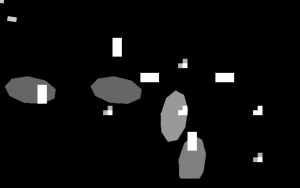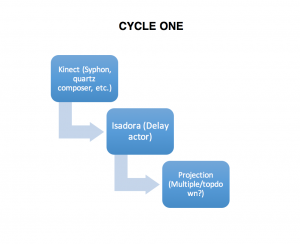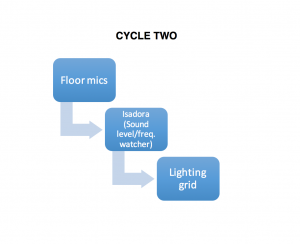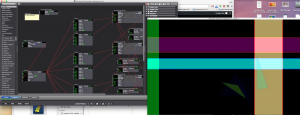Pressure Project 1 __ Taylor
Posted: September 22, 2016 Filed under: Assignments, Isadora, Pressure Project I, Reading Responses, Taylor | Tags: #frogger:) Leave a comment »Under Pressure, dun dun dun dadah dun dun
Alright… so I got super frustrated fiddling around in Isadora and my system ended up being what I learned from my failures in the first go round. Which was nice because I was able to plan based on what I couldn’t and didn’t want to do, leading me to make simpler choices. It seemed like everyone was enthusiastically trying to grok how to interact with the system. It felt like it kept everyone entertained and pretty engaged for more than 3 minutes. ? Some of the physical responses to my system were getting up on the feet, flailing about, moving left to right and using the depth of the space, clapping, whistling, and waving. Some of the aesthetic responses to my system were that the image reminded them of a microscope or a city. I tried to use slightly random and short intervals of time between scenes and build off of simple rules and random generators (and slight variations of the like), in an attempt to distract the brain away from connecting the pattern. For a time it seemed this proved successful, but after many cycles and finding out the complexities were more perceived than programmed enthusiasm waned. I really enjoyed this project and the ideas of scoring and iterations that accompanied it.
Actors I jotted down, that I liked in others processes: {user input/output/ create inside user actor}{counter/certain#of things can trigger}{alpha channel/ alpha mask}{chroma keying/ color tracking}{motion blur / can create pathways with rate of decay ? }{gate / can turn things on/off}{trigger value}
Reading things:
media object- representation
interaction, character, performer
scene, prop, Actor, costume, and mirror
space & time | here, there, or virtual / now or then
location anchored to media (aural possibilities), instrumental relationship, autonomous agent/ responsive, merging to define identity (cyborg tech), “the medium not only reflects back, but also refracts what is given” (love this). “The interplay between dramatic function / space / time is the real power — expansive range of performative possibilities …< <107/8ish.. maybe>>
Ideation of Prototype Summary- C1 + C2
Posted: October 26, 2015 Filed under: Alexandra Stilianos, Assignments 1 Comment »My final project unfolds in 2 cycles that culminate to one performative and experiential environment where a user can enter the space wearing tap dance shoes and manipulate video and lights via the sounds from the taps and their movement in space. Below is an outline of the two cycles I plan to actualize this project.
Cycle one: Friederweiss-esque video follow
Goal: Create a patch in Isadora that can follow a dancer in space with a projection. When the dancer is standing still the animation is as well and as the performer accelerates through the space the animation leaves a trail that is proportionate to the distance and speed traveled.
Current state: I attempted to use Syphon into Quartz Composer to be able to read skeleton data from the Kinect to use in Isadora and met some difficulties installing and understanding the software. I referenced Jamie Griffiths blogs linked below.
http://www.jamiegriffiths.com/kinect-into-isadora
http://www.jamiegriffiths.com/new-kinect-into-syphon/
Projected timeline: 3-4 more classes to understand and implement software into Isadora and then create and utilize patch.
Cycle two: Audible tap interactions
Goal: Create environment that can listen to the frequency and/or amplitude of the various steps and sounds a tap shoe can create and have those interactions effect/control the lighting for the piece.
Current State: Not attempted this yet since still in C1 but my classmate Anna Brown Massey did some work with sound in our last class that may be helpful to me when I reach this stage.
Current questions: How do I get the software to recognize frequency in the tap shoes since the various step create different sounds. Is this more reliable or difficult than using volume alone, as it is definitely more interesting to me.
Projected timeline: 3+ classes, no use yet with this kind of software so a lot of experimentation expected.
Posted: September 14, 2015 Filed under: Alex Oliszewski, Assignments, Pressure Project 2 Leave a comment »
Oliszewski Generative Assignment.izz
Hey all, check out the Isadora file I have attached above. Try double clicking on some of the usermade actors in this program. (Triangle mover) (Line Mover).
There are also a couple of special actors embedded in this project. Namely the “Drift Random” actor. (You can find it inside the Drift Random/Smoothed actor.)
Feel free to use anything from this patch in working on your own.
-Alex
Week 3 Reading Response
Posted: September 9, 2015 Filed under: Assignments, Reading Responses, Sarah Lawler Leave a comment »There is only software
It’s fascinating to associate “digital” with “software” so directly. Of course software is the backbone of all media. Using the word “software” can seem intimidating to use. Software itself is a whole other language. Users use the word “digital” because they can associate with understanding how to use an app. If the user used “software” it implies that the user understands not only the app, but how it was built. I do agree that we should be taught what we use and rely on every day. It seems that Manovich has an underlying tone throughout the reading to appreciate what is being created and shared.
Jean Baudrillard A Very Short Introduction
This was most certainly a difficult read. I know as a society we have can get lost in what is real or not. However, I’m not sure if Baudrillard was leading to this or not, but here’s my takeaway. War is reality to him. Postmortem only takes effect after war, according to him. He even backtracks what he says about American culture when 9-11 happened, but criticizes how the military handled it. I think he makes some great points, but there is this certainly a pretentious air about Baudrillard’s work.
Dialogue with the Machines
I don’t think a computer needs to be an AI in order to classify it as interactive. The computer itself doesn’t speak to us. It does however, carry its own type of language that does allow users to learn from other users. If the user is capable, he/she could find out almost anything on their own using a computer. In a way the internet is the “human dialogue partner” and the computer serves as a medium. I mean, don’t get me wrong, I wouldn’t be upset if I could have my own personal Jarvis in the future.
First Assets for Isadora
Posted: September 4, 2015 Filed under: Alex Oliszewski, Announcements, Assignments Leave a comment »Here you can find some videos that will be using in our first moments with Isadora.
Please download these to your local computer so we can use them in class.
Isadora Tutorials
Posted: September 4, 2015 Filed under: Alex Oliszewski, Assignments Leave a comment »This is the first of 10 or so tutorial videos introducing you to Isadora and its creator Mark.
You can find the rest here: https://www.youtube.com/watch?v=VqNw_4AWvvA
Hey there! Check out the Sep 1 Readings!
Posted: March 30, 2015 Filed under: Alex Oliszewski, Announcements, Assignments Leave a comment »Please provide your responses in a new post categorized under your name.




